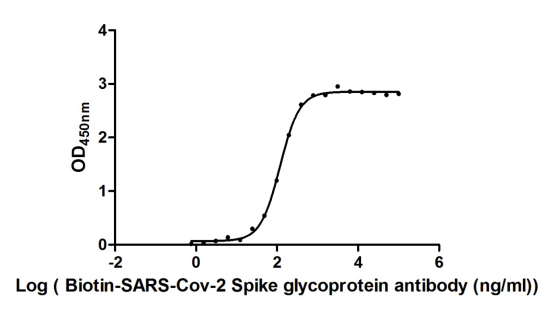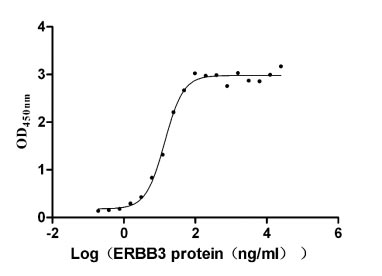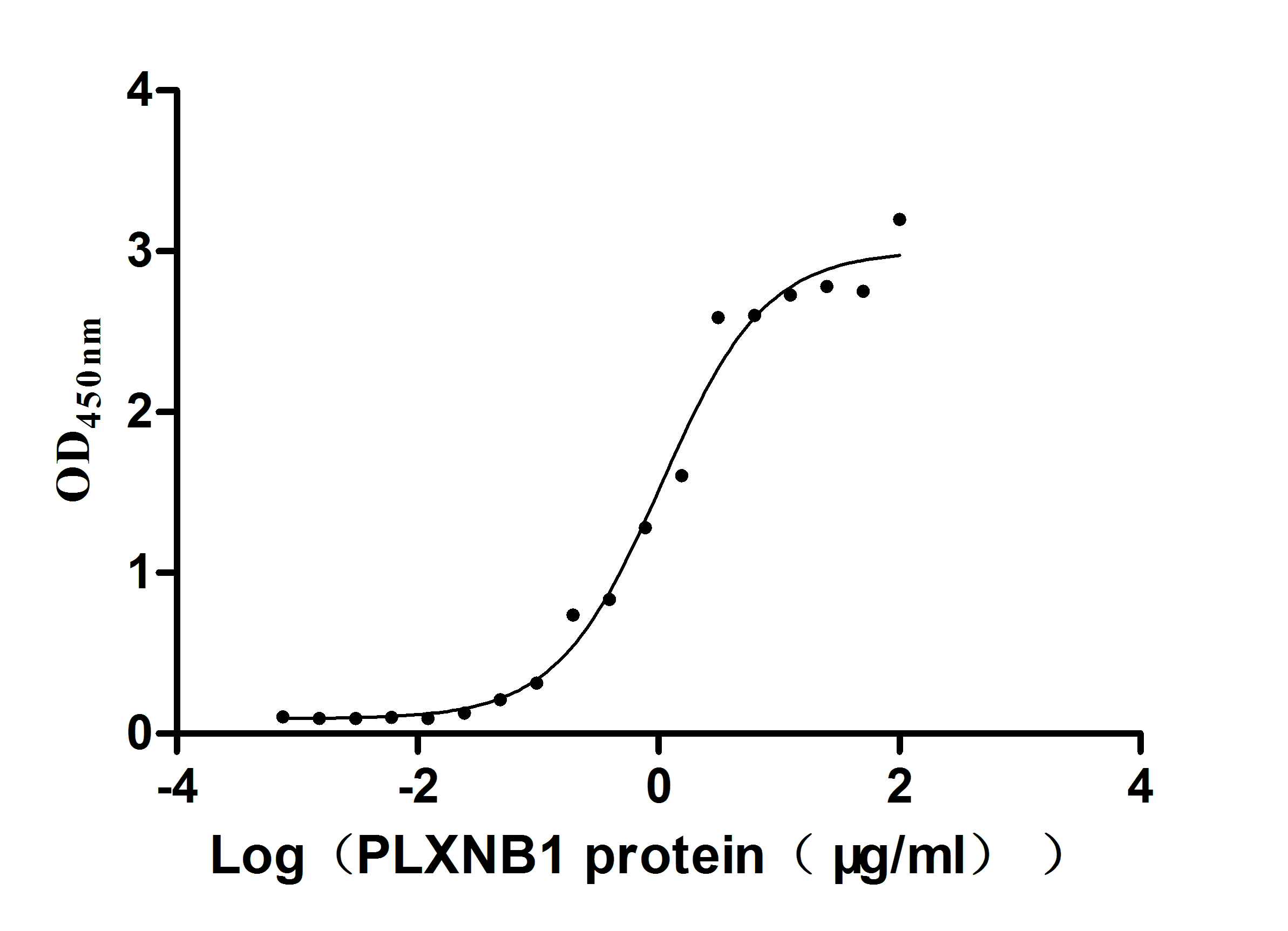Recombinant Human C-C motif chemokine 17 (CCL17)
-
货号:CSB-YP856406HU
-
规格:
-
来源:Yeast
-
其他:
-
货号:CSB-EP856406HU
-
规格:
-
来源:E.coli
-
其他:
-
货号:CSB-EP856406HU-B
-
规格:
-
来源:E.coli
-
共轭:Avi-tag Biotinylated
E. coli biotin ligase (BirA) is highly specific in covalently attaching biotin to the 15 amino acid AviTag peptide. This recombinant protein was biotinylated in vivo by AviTag-BirA technology, which method is BriA catalyzes amide linkage between the biotin and the specific lysine of the AviTag.
-
其他:
-
货号:CSB-BP856406HU
-
规格:
-
来源:Baculovirus
-
其他:
-
货号:CSB-MP856406HU
-
规格:
-
来源:Mammalian cell
-
其他:
产品详情
-
纯度:>85% (SDS-PAGE)
-
基因名:
-
Uniprot No.:
-
别名:A-152E5.3; A152E53; ABCD 2; ABCD2; C-C motif chemokine 17; CC chemokine TARC; CCL17; CCL17_HUMAN; Chemokine CC Motif Ligand 17; MGC138271; MGC138273; SCYA17; Small Inducible Cytokine A17; Small Inducible Cytokine A17 Precursor; Small Inducible Cytokine Subfamily A (Cys Cys); Small Inducible Cytokine Subfamily A (Cys Cys) Member 17; Small-inducible cytokine A17; T Cell Directed CC Chemokine; Thymus and activation regulated chemokine ; Thymus and activation-regulated chemokine
-
种属:Homo sapiens (Human)
-
蛋白长度:Full Length of Mature Protein
-
表达区域:24-94
-
氨基酸序列ARGTNVG RECCLEYFKG AIPLRKLKTW YQTSEDCSRD AIVFVTVQGR AICSDPNNKR VKNAVKYLQS LERS
-
蛋白标签:Tag type will be determined during the manufacturing process.
The tag type will be determined during production process. If you have specified tag type, please tell us and we will develop the specified tag preferentially. -
产品提供形式:Lyophilized powder
Note: We will preferentially ship the format that we have in stock, however, if you have any special requirement for the format, please remark your requirement when placing the order, we will prepare according to your demand. -
复溶:We recommend that this vial be briefly centrifuged prior to opening to bring the contents to the bottom. Please reconstitute protein in deionized sterile water to a concentration of 0.1-1.0 mg/mL.We recommend to add 5-50% of glycerol (final concentration) and aliquot for long-term storage at -20℃/-80℃. Our default final concentration of glycerol is 50%. Customers could use it as reference.
-
储存条件:Store at -20°C/-80°C upon receipt, aliquoting is necessary for mutiple use. Avoid repeated freeze-thaw cycles.
-
保质期:The shelf life is related to many factors, storage state, buffer ingredients, storage temperature and the stability of the protein itself.
Generally, the shelf life of liquid form is 6 months at -20°C/-80°C. The shelf life of lyophilized form is 12 months at -20°C/-80°C. -
货期:Delivery time may differ from different purchasing way or location, please kindly consult your local distributors for specific delivery time.Note: All of our proteins are default shipped with normal blue ice packs, if you request to ship with dry ice, please communicate with us in advance and extra fees will be charged.
-
注意事项:Repeated freezing and thawing is not recommended. Store working aliquots at 4°C for up to one week.
-
Datasheet :Please contact us to get it.
相关产品
靶点详情
-
功能:Chemotactic factor for T-lymphocytes but not monocytes or granulocytes. May play a role in T-cell development in thymus and in trafficking and activation of mature T-cells. Binds to CCR4.
-
基因功能参考文献:
- The frequency of the CC genotype in the TARC rs223828 SNP was higher in patients with intractable Graves disease than in patients with Graves disease in remission. PMID: 29848886
- The expression of CCL17 was decreased in nasal polyp (NP) epithelium compared to the epithelium of normal ethmoid sinus, whereas the expression of CCL22 was not decreased. E-cadherin was differentially distributed between the epithelium of normal ethmoid sinus and NP epithelium. EGFR was also decreased in NPs. PMID: 29746583
- TARC serum levels were elevated in 78% of sarcoidosis patients and correlated with disease severity. PMID: 29598931
- Serum TARC level may be a potent marker reflecting better response to IL-17A inhibitors for psoriasis treatment. PMID: 29655215
- This review presents key clinical studies of Multiple sclerosis together with experimental studies in animals that have demonstrated functional roles of CCR4, CCL17, and CCL22 in experimental autoimmune encephalomyelitis pathogenesis. [review] PMID: 29099057
- Taken together, our data showed a likely positive feedback mechanism of enhanced IL-6 production in ectopic milieu. The high levels of IL-6 in the peritoneal cavity stimulate the expression of CCL17 in endometrial stromal cells by activating JNK signal pathway, and then, CCL17 further induces CCR4 expression on macrophages, which eventually leads to an increase in IL-6 production via NF-kappaB activation. PMID: 28240436
- Data suggest that high levels of CCL17 and CCL22 in endometrium in women with endometriosis promote (1) recruitment of Tregs, (2) immunosuppression of Tregs, and (3) angiogenesis in endometrium. (Tregs = regulatory T cells) PMID: 28383711
- Serum TARC levels correlate well with indicators of systemic inflammation and of disease severity among patients with a drug eruption except SJS/TEN. Serum TARC may be a prognostic biomarker of severity of inflammation in drug eruptions. PMID: 28648978
- TARC production in HaCaT keratinocytes through the interaction between IL-22 and IL-22Ralpha facilitates T-cell migration in atopic dermatitis caused by house dust mites. PMID: 26914146
- TARC is a candidate biomarker for PTSD only in males. PMID: 28170001
- High CCL17 expression is associated with colon cancer cell migration. PMID: 28146427
- GM-CSF can mediate inflammation and pain by regulating IRF4-induced CCL17 production PMID: 27525438
- Based on the ADEPT study data set, we report that airway mucosal expression of CCL26 was a robust discriminator of type 2 inflammation from healthy nonatopic subjects. Furthermore, airway mucosal CCL26 expression was best identified by using a panel of clinical biomarkers, including Feno values, bEOS counts, and expression of 2 novel markers, sCCL17 and sCCL26 PMID: 28089872
- Low CCL17 expression is a potential independent adverse prognostic biomarker for recurrence and survival of patients with clear cell renal cell carcinoma after nephrectomy. PMID: 28178948
- IP-10 serum increase or TARC/IP-10 ratio decrease along with abnormal hepatic enzymatic alteration could signify early rejection of the transplanted liver. PMID: 28245475
- elevated pre-treatment levels of sGal-1, sCD163, sCD30 and TARC can be found in patients with classic Hodgkin lymphoma. However, only plasma TARC accurately reflects disease activity and correlates with clinical treatment response. PMID: 27610595
- levels elevated in rheumatoid arthritis synovial fluid, due to production by mononuclear cells, particularly CD1c classical dendritic cells PMID: 27250804
- Serum TARC levels are well correlated with blood eosinophil counts in patients with generalized drug eruptions, indicating that Th2-type immune reactions underlie TARC production. Serum TARC measurements also have potent diagnostic value for DIHS, with high sensitivity and specificity. PMID: 27497618
- Data suggest that Th1 (IFN-gamma-inducible protein-10 IP-10/CXCL10) and Th2 (thymus and activation regulated chemokine TARC/CCL17) and (macrophage derived chemokine MDC/CCL22) cooperatively play a role in the development of ankylosing spondylitis (AS). PMID: 26827189
- CCL17 positively regulates the tumorigenesis of hepatocellular carcinoma.Higher levels of intratumoral CCL17 expression are associated with poorer survival of hepatocellular carcinoma patients. PMID: 26781124
- CCL17 and CCL18 dermal expression is associated with leprosy polarity. PMID: 25412496
- The SNP rs223895 in TARC/CCL17 gene is associated with the susceptibility to Kawasaki disease. PMID: 26182268
- Serum CCL17 levels are associated with coronary artery disease and atherosclerosis severity independently of traditional cardiovascular risk factors. PMID: 25555269
- TARC was correlated with disease status and its monitoring may be able to predict PET positivity after alloSCT, thus potentially allowing an early immune manipulation. PMID: 25240818
- Serum levels of CCL17 were positively correlated with coronary artery disease. PMID: 25062565
- increased expression in the thymus of myasthenia gravis patients PMID: 24397961
- TARC and interleukin-31 may be biomarkers for adult atopic dermatitis PMID: 24984931
- Serum TARC is a promising biomarker for remission and can be used for accurately monitoring proactive treatment for long-term control. [revew] PMID: 24628072
- disease activity and response biomarker in alopecia areata PMID: 24102731
- High CXCL10 levels were detected in acutely infected children regardless of virus pathogen, whereas increased CCL17 production was RSV-specific PMID: 25013801
- Higher serum concentrations of CCL17 at baseline may be predictive of acute exacerbations in patients with chronic hypersensitivity pneumonitis PMID: 23705860
- might be potential marker of non-eosinophilic oesophagitis gastrointestinal food allergies PMID: 24698291
- Serum TARC may represent a suitable biomarker for monitoring of atopic dermatitis severity in daily practice. PMID: 25199679
- Although TARC and I-TAC may not directly regulate pruritus in atopic dermatitis patients, these chemokines are very sensitive disease markers of AD. PMID: 24104601
- we found that TARC is an easily measured biomarker that is associated with faster TTR, longer PFS, and possibly longer OS in a population of patients with HL who were treated with panobinostat. PMID: 23822537
- The serum TARC level is a very sensitive biomarker for monitoring the severity and treatment response in AD PMID: 25268342
- CCL17 is an antimicrobial protein with bacteriocidal activity against E. coli and S. aureus. PMID: 12949249
- An association between TARC/CCL17 polymorphisms, susceptibility of Kawasaki disease, and intravenous immunoglobulin responses in Kawasaki disease patients. PMID: 23942559
- Migration assays were performed to evaluate CCL17-induced colon cancer cell (HT-29) chemotaxis and RhoA protein levels were quantified. PMID: 24582560
- Ginseng inhibited TARC expression via blockade of NF-kappaB activation in HaCaT cells. PMID: 23454147
- CCL17-induced, CCR4-dependent release of CGRP by human airway epithelial cells represents a novel inflammatory pathway in patients with asthma and allergic disease. PMID: 23731651
- These data reveal an elevated serum concentration of Th2-attracting chemokines CCL22 and CCL17 in opsoclonus-myoclonus syndrome. PMID: 23340773
- Autistic children had significantly higher serum levels of TARC than healthy controls PMID: 23782855
- Serum CD163 and TARC as disease response biomarkers in classical Hodgkin lymphoma. PMID: 23224400
- Data suggest an important role for serum CCL17 level as biomarker of drug resistance/remission induction in Hodgkin lymphoma in response to various combined neoplastic agent protocols. PMID: 23225085
- increased expression in macrophages from asthmatic patients PMID: 22981793
- Data show that PD-1, PD-L1, PD-L2, CCL17, and CCL22 mRNA was identified in papillomas. PMID: 22322668
- Serum concentrations of TARC and CTACK were significantly higher in AD (atopic dermatitis) children than in healthy controls, and correlated with severity of symptoms. PMID: 22017510
- Baseline plasma thymus and activation-regulated chemokine levels correlate with classical Hodgkin's lymphoma tumor burden and serial levels correlate with response to treatment in patients with classical Hodgkin's lymphoma. PMID: 22058214
- PI16-positive Treg showed enhanced in vitro migration towards the inflammatory chemokines CCL17 and CCL20, suggesting they can migrate to sites of inflammation PMID: 22533972
显示更多
收起更多
-
亚细胞定位:Secreted.
-
蛋白家族:Intercrine beta (chemokine CC) family
-
组织特异性:Expressed at high levels in thymus and at low levels in the lung, colon and small intestine.
-
数据库链接:
HGNC: 10615
OMIM: 601520
KEGG: hsa:6361
STRING: 9606.ENSP00000219244
UniGene: Hs.546294
Most popular with customers
-
Recombinant Severe acute respiratory syndrome coronavirus 2 Spike glycoprotein (S), partial (Active)
Express system: Mammalian cell
Species: Severe acute respiratory syndrome coronavirus 2 (2019-nCoV) (SARS-CoV-2)
-
Recombinant Human Receptor tyrosine-protein kinase erbB-3 (ERBB3), partial (Active)
Express system: Mammalian cell
Species: Homo sapiens (Human)
-
Recombinant Human Plexin-B1 (PLXNB1), partial (Active)
Express system: Mammalian cell
Species: Homo sapiens (Human)
-
Recombinant Human Zymogen granule protein 16 homolog B (ZG16B) (Active)
Express system: Mammalian cell
Species: Homo sapiens (Human)
-
Recombinant Human Dickkopf-related protein 1 (DKK1) (Active)
Express system: Mammalian cell
Species: Homo sapiens (Human)
-
Recombinant Human C-C chemokine receptor type 8 (CCR8)-VLPs (Active)
Express system: Mammalian cell
Species: Homo sapiens (Human)






-AC1.jpg)











